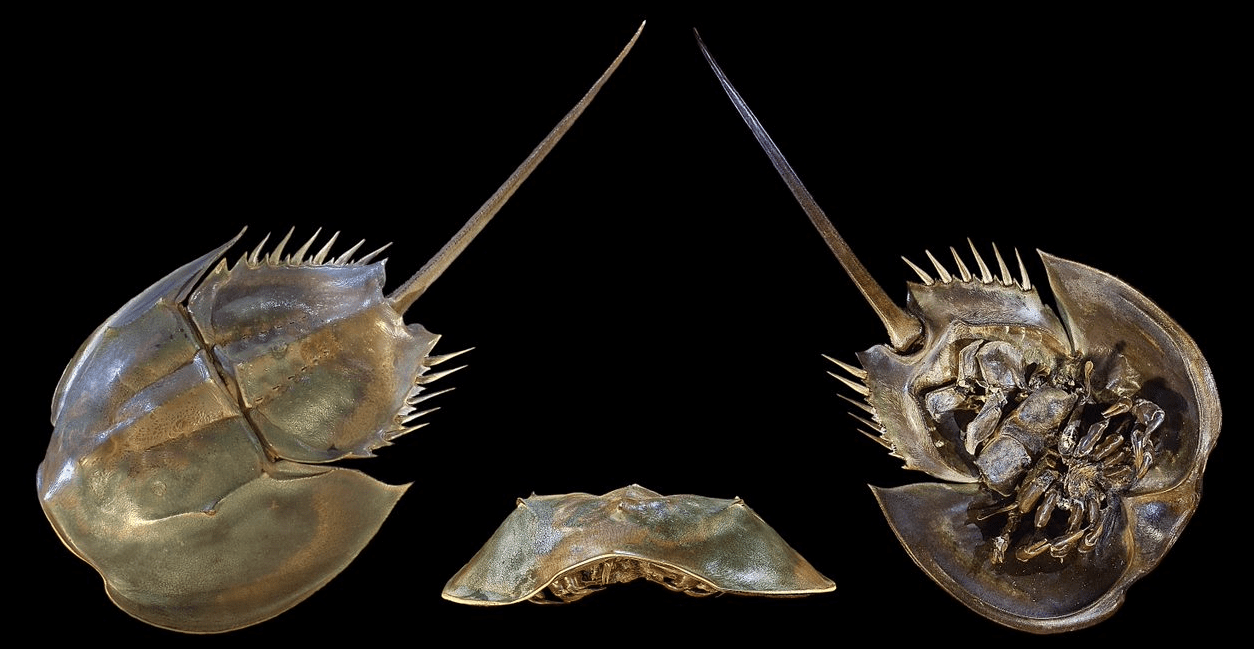Howard Fischer
Uppsala, Sweden
 |
|
Horseshoe crab. Crop of photo by Didier Descouens, 2009, via Wikimedia. CC BY-SA 4.0. |
The horseshoe crab (Limulus polyphemus) has not changed in more than 450 million years. It has been called “a living fossil.”1 It is, in fact, not a crab at all, but an arthropod, more closely related to arachnids such as spiders and scorpions. It is found on the eastern coast of North America and lives in shallow water, coming to shore to reproduce and lay eggs. The Atlantic or American horseshoe crab is about 50 cm long and weighs 2 kg.2
Horseshoe crabs were used in cardiac experiments by Swedish-born American physiologist Anton J. Carlson (1875–1956) at the turn of the twentieth century.3,4 These caused him to be recognized as a promising physiologist and he became a leader in his field. He spent his entire career at the University of Chicago.5
Fifty years later, in 1956, Dr. Frederick Bang discovered that horseshoe crab blood will coagulate in the presence of bacterial endotoxins, even if the bacteria themselves have been killed. The clotting of the horseshoe crab’s blue blood (it contains copper, not iron) is due to amebocytes, motile blood cells in the animal’s circulation.6 This system of entrapping gram- negative bacteria evolved because the seawater in which horseshoe crabs live contains one million gram-negative bacteria per milliliter, and the sand it sometimes occupies contains one billion bacteria per gram.7 It is, simply, what keeps the animal alive in a dangerous environment. In the laboratory, the amebocytes can be broken open (“lysed”) to produce “Limulus amebocyte lysate,” a substance that can be used to test for the presence of endotoxin.
The US Food and Drug Administration (FDA) and other regulatory agencies mandate that intravenous fluids, injectable medications, and implantable devices used in human and veterinary medicine be tested for the presence of endotoxin before being put on the market.8 The Limulus lysate test takes forty-five minutes, compared to the previous technique of injecting rabbits with the substance to be tested and waiting days to see if a fever would develop. The FDA approved the Limulus lysate test in 1977 as an alternative to the slow and expensive use of rabbits.9
Horseshoe crab blood, the source of amebocytes used to produce the lysate, is very expensive. In Singapore, a quart (nearly a liter) of this blood costs US$ 15,000. In 1986, researchers at Kyushu University in Japan found that the clotting factor in the Limulus lysate, “factor C,” was an enzyme that could be used instead of the entire lysate. A recombinant factor C was later produced by genetic engineering. This could end the use of horseshoe crab blood, the “harvesting” of which kills between 3–30% of the animals used.10 European countries started using the recombinant factor C for endotoxin testing in 2016,11 but as of 2020 the US Food and Drug Administration had not yet approved this technique.12
References
- Sara Zhang. “The last days of the blue-blood harvest,” The Atlantic, 2018.
- “Horseshoe crab.” Wikipedia.
- Anton Carlson. “The nervous origin of the heartbeat in Limulus, and the nervous nature of coordination or conduction in the heart,” Am J Physiol, 12(1), 1904.
- Anton Carlson. “Nature of cardiac inhibition with special reference to the heart of Limulus.” Am J Physiol, 13, 1905.
- Hasse Abrahamson. “Anton Julius Carlson från Bohuslan: En portalfigur inom fysiologi och humanism,” Läkartidningen, 119, 2022.
- “Horseshoe crab.” Wikipedia.
- Lenka Huron. “Reducing post-bleeding mortality of horseshoe crabs (Limulus polyphemus) used in the biomedical industry,” [Thesis] 2003. http://hdl.handle.net/10919/36231.
- Zhang. “Harvest.”
- Thomas Novitsky. “Biomedical applications of the Limulus amebocyte lysate.” In: J. Tancredi et al., eds, Biology and Conservation of Horseshoe Crabs, Cham, Switzerland: Springer, 2009.
- “Horseshoe crab.” Wikipedia.
- “Limulus amebocyte lysate.” Wikipedia.
- “Horseshoe crab.” Wikipedia.
HOWARD FISCHER, M.D., was a professor of pediatrics at Wayne State University School of Medicine, Detroit, Michigan.

Leave a Reply